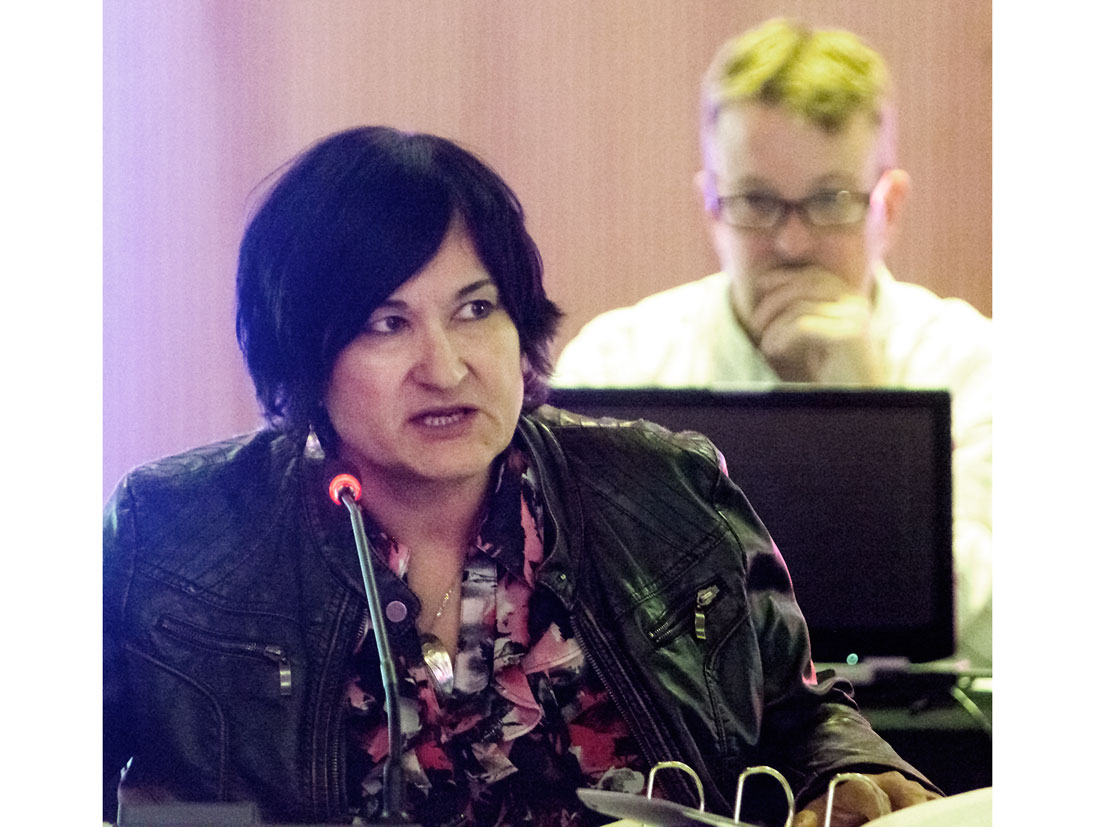
Photo by Whitehorse Star
Pauline Frost

Photo by Whitehorse Star
Pauline Frost
The annual return of fall chum salmon on the Porcupine River is in trouble, and the community of Old Crow is worried.
The annual return of fall chum salmon on the Porcupine River is in trouble, and the community of Old Crow is worried.
The international Yukon River Panel visiting Whitehorse this week for its annual spring management meeting heard how something more needs to be done to revive and protect the run.
Phil Timpany told the panel he was disturbed by what he saw last fall at the bear viewing facility he operates in partnership with the Vuntut Gwitchin First Nation on the Fishing Branch River, part of the Porcupine watershed.
Where there would normally be 10,000 chum spawning, he estimated there were 700, he told the panel members.
“What I did see last year was something I thought I would never see in my lifetime.”
So concerned were they over the lack of salmon, they flew the river to see if some natural event had somehow blocked the river, he said.
Timpany said he’s heard that the Americans have said they can’t do anything on the Alaskan side of the border where the Porcupine fall chum must pass through before passing Old Crow and moving on to the Fishing Branch River.
“I find it difficult that nothing can be done,” he told panel members.
Old Crow youth Erika Tizya cautioned the board about the messaging when communities along the mainstem of the Yukon River are being encouraged to fish the healthier chum runs as a substitute for the loss of their chinook salmon fishery.
Panel member Pauline Frost is also the chair of the Yukon Salmon Sub-committee. She comes from Old Crow, and she too voiced concern over the Porcupine River chum run in her closing remarks yesterday as the five-day meeting wound down at the Kwanlin Dun Cultural Centre.
Frost stumbled briefly on emotion as she acknowledged and thanked representatives of several Yukon First Nations who told the panel of how their cultural ties to the chinook salmon have been shattered by the poor state of the chinook stock.
In Old Crow, the only isolated community in the Yukon, they know the importance of living off the land, she said.
Frost said they too have lost the once bountiful run of chinook and now they’re concerned they’re about to lose their ability to harvest fall chum.
Timpany said the chum run is also responsible for the gathering of 30 grizzly bears a year on average who come to the foot of Bear Cave Mountain on the Fishing Branch River to feast on chum in the late fall.
It presents a world-class wildlife viewing opportunity that could be lost, he said.
Resource manager Mary-Ellen Jarvis of the federal Department of Fisheries and Oceans told the Yukon River Panel this year’s return of fall chum on the Porcupine is expected to be poor, even below the minimum goal for spawning.
While the target for spawning escapement is between 22,000 and 49,000, this year’s forecast for fall chum calls for a return of less than 20,000, Jarvis told panel members.
Last year’s sonar counts at Old Crow estimate the total return for the Porcupine River watershed was 17,756, well below the minimum escapement target.
On the other hand, this year’s return of fall chum along the mainstem of the Yukon River is estimated at 236,000 to 294,000, more than double the minimum targets for spawning escapements.
In the last decade or more, the prized chinook salmon stocks have taken a nosedive in the Yukon River. So much so that Alaska implemented a total ban on fishing last year, and Yukon First Nations volunteered a total ban on this side of the border.
But for years Yukon First Nations were being forced to cut back because the number of chinook crossing into the Yukon just wasn’t enough to support a large harvest while maintaining sufficient numbers for spawning.
For years, Yukon First Nations were calling upon Alaskan communities to reduce their subsistence food fishery because they were catching too many chinook of Canadian origin, and were ultimately hurting the future of the chinook salmon.
Records for last year estimate the total harvest of fall chum in Alaska was 200,140, with the subsistence fishery harvesting 84,230 and the commercial fishery taking 115,593.
The harvest of fall chum in the Yukon on the mainstem was 3,050, split between 546 harvested by the aboriginal food fishery and 2,485 taken by the commercial boats out of Dawson City.
The Porcupine River harvest by the Vuntut Gwitchin of Old Crow was estimated at 1,983, according to records.
The average Old Crow harvest between 1961 and 2013 was 4,448.
In order to encourage thoughtful and responsible discussion, website comments will not be visible until a moderator approves them. Please add comments judiciously and refrain from maligning any individual or institution. Read about our user comment and privacy policies.
Your name and email address are required before your comment is posted. Otherwise, your comment will not be posted.
Be the first to comment